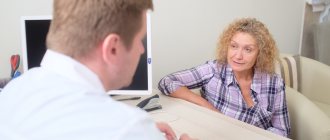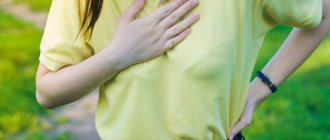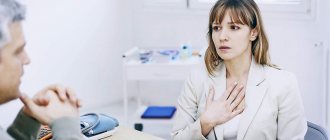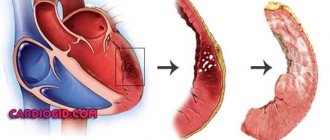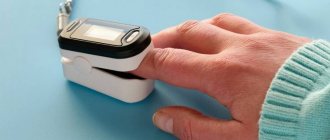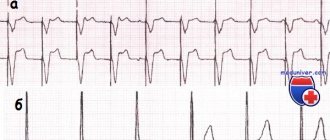Patient complaints that he does not have enough air are not uncommon. Almost everyone has encountered this phenomenon in their life, but not everyone knows that its systematic appearance can be a symptom of a number of pathological conditions that require immediate treatment.
The problem can occur when inhaling (inspiratory dyspnea) or when exhaling, when due to a lack of air it is difficult to exhale (expiratory dyspnea). If both signs alternate, this is mixed shortness of breath. In the process, the person feels a lack of oxygen and breathes heavily with a whistling sound.
Such conditions are typical for pregnant women, patients suffering from pathologies of the heart, pleura or lungs, as well as with traumatic injuries and neuroses. CELT specialists will help determine the reason why there is not enough air when breathing and alleviate the condition. You can find out the cost of our services by going to the “Services and Prices” tab. To avoid misunderstandings, we recommend that you contact our operators to clarify the numbers.
Characteristic symptoms
Shortness of breath with coronavirus: how to understand ? It is difficult for the patient to take a deep breath. He makes at least twenty respiratory movements, which is typical for the moderate severity of the disease. As for the severe degree, it is characterized by more than thirty respiratory movements per minute.
At the same time, severe inflammatory processes occur in the lungs: a person’s body temperature rises, but in some situations, shortness of breath with coronavirus without fever , a dry cough is bothersome. But in some cases there may be no symptoms. Then the cough is caused by fear and panic.
If pneumonia is present, during auscultation the doctor hears whistling and wheezing in the bronchi. This is often typical for patients with concomitant bronchial asthma, chronic bronchitis and in the presence of secondary lung damage. Subsequently, if treatment is not timely, edema of the pulmonary tissue may develop - this is a life-threatening condition.
When to see a doctor?
If it becomes difficult to breathe while lying down, this is an alarming symptom, and you should not delay consulting a doctor. In order to diagnose the disease in time and begin treatment, it is important to contact a pulmonologist, cardiologist or therapist as early as possible. The doctor conducts an examination and, if necessary, refers to other specialists. Based on diagnostic data, a treatment regimen is drawn up.
References
- Klyushnikov S.A. et al. Clinical case of Pompe disease with late onset //Nervous diseases, 2015. No. 2.
- Sukhorukov V.S. et al. Diagnosis of Pompe disease // Russian Bulletin of Perinatology and Pediatrics, 2010. T. 55. No. 6.
- McGee S. Evidence-based physical diagnosis e-book. – Elsevier Health Sciences, 2012; p.145-155.
- Radiation methods for diagnosing heart disease / Manfred Thelen, Raimund Erbel, Karl-Friedrich Kreitner, Jörg Barkhausen; lane with him. ; under general ed. prof. V.E.Sinitsyna. – M.: MEDpress-inform, 2011. – 408 p. : ill.
- Belovol A. N., Knyazkova I. I., Gridasova L. N. Diagnosis of chronic heart failure in patients with chronic obstructive pulmonary disease // Scientific bulletins of Belgorod State University. Series: Medicine. Pharmacy, 2014. T. 28. No. 24 (195).
- Chuchalin A.G. Pulmonary edema: treatment programs //Practical Pulmonology, 2005. No. 4.
- Frolova E. B., Yaushev M. F. Modern understanding of chronic heart failure // Bulletin of modern clinical medicine, 2013. T. 6. No. 2.
- Pompe Disease More Common Than Previously Believed, Experts Say. Pompe Disease News. URL: https://pompediseasenews.com/2019/05/08/pompe-disease-more-common-than-previously-believed-experts-say/ (accessed 09/13/2019).
- Shchukina S.V. et al. Frequency and degree of shortness of breath in patients with ankylosing spondylitis // Siberian Medical Journal (Irkutsk), 2007. T. 74. No. 7.
GZEA.PD.18.09.0435q
What are the characteristics of breathing complications after suffering from covid-19?
Symptoms of shortness of breath with coronavirus:
- feeling of tightness in the chest,
- rapid breathing,
- superficial breathing movements,
- It's difficult to take a deep breath.
coronavirus shortness of breath symptoms
The presence of shortness of breath in healthy people does not always indicate pathology. It can normally occur in athletes and runners. It can also occur in ordinary people during physical activity. But after suffering from covid-19, shortness of breath occurs even at rest, the body is starved of oxygen, which disrupts its vital functions.
Prevention and recommendations for shortness of breath
Physiological shortness of breath goes away on its own after the person has rested. However, if the problem arose acutely and suddenly, the following measures should be taken to alleviate his condition:
- Calm down and sit on a sofa or chair, comfortably resting your back;
- Remove or unfasten tight clothing, a belt that is too tight;
- Provide fresh air by opening a window or door;
- Humidify the air by hanging a pre-wetted sheet near the patient;
- Offer a herbal sedative.
If a person knows about his illness and he has drugs that alleviate his condition, he should be offered to drink them. If he does not feel better within fifteen minutes, he will have to call an ambulance.
There is no specific prevention in this case. However, you can minimize the risk of developing this condition by following these rules:
- Maintaining an active, healthy lifestyle;
- Avoiding excessive physical activity and stress;
- Body weight control;
- Timely treatment of diseases;
- Systematic completion of preventive studies.
Remember: lack of air can be a sign of serious pathological conditions. That is why CELT specialists recommend promptly finding out its causes and taking appropriate measures!
Make an appointment through the application or by calling +7 +7 We work every day:
- Monday—Friday: 8.00—20.00
- Saturday: 8.00–18.00
- Sunday is a day off
The nearest metro and MCC stations to the clinic:
- Highway of Enthusiasts or Perovo
- Partisan
- Enthusiast Highway
Driving directions
What types of shortness of breath are there after coronavirus?
Doctors distinguish two types of shortness of breath after coronavirus , which occur in patients in this group:
- Emerging gradually. A person feels difficulty during inhalation and exhalation not only during exercise, but also at rest. Worsening occurs at night, and signs of suffocation may occur. When you raise your arms up, the patient's condition is better.
- Sudden shortness of breath. It occurs against a background of complete well-being and is accompanied by headache and sweating. It is impossible to take a full breath, the fear of death arises.
Both options require emergency medical attention. Because at any moment the patient’s condition may worsen and breathing will become impossible. Now you know what shortness of breath is like with coronavirus .
How to assess lung function after coronavirus?
A breath test should be performed. You can do it yourself at home:
- take a deep breath through your nose,
- hold your breath for ten seconds,
- exhale slowly.
In the absence of any discomfort, cough or sore throat, the lungs are healthy. If your health worsens and these symptoms occur, you should immediately seek medical help. You can find a video on the forum on how to properly do a lung assessment.
Features of heavy inhalation and exhalation
A condition where it is difficult for a patient to take a deep breath can provoke the following manifestations:
- significant decrease in performance;
- feeling of constant fatigue;
- prostration;
- headache;
- various sleep disorders;
- disruptions in the gastrointestinal tract (diarrhea, flatulence, constipation);
- anxiety, depression, restlessness;
- nervousness, fussiness;
- feeling of helplessness.
As a rule, a patient with respiratory disorders is forced to focus all the time on how he is breathing - disruptions in the respiratory rhythm are difficult to miss.
The main danger of such “behavior” is that it can lead to the development of respiratory neurosis in the patient - a condition in which a person constantly checks how complete his inhalation or exhalation is. With neurosis, even the slightest deviations in the respiratory rhythm are perceived by the patient as a threat to life, as a result of which anxiety increases significantly. Neurotics often only imagine that they feel some discomfort, experience a feeling of suffocation, and cannot absorb enough air. But even such imaginary symptoms can provoke the development of a panic attack, accompanied by a fear of death.
Self-diagnosis problems
Difficulty breathing, for example, during nasal congestion and when the functioning of the lungs is impaired, are completely different things. It is impossible to figure out the cause of shortness of breath on your own.
treatment of shortness of breath due to coronavirus
You should seek medical help from your family doctor or pulmonologist. You should not self-medicate.
VSD in faces
This page contains excerpts from patient histories, covering the main complaints with which people turn to us for help. This is done with the goal of showing how different and “complex” the symptoms of vegetative-vascular dystonia can be. And how closely it is sometimes “fused” with disturbances in the functioning of organs and systems. How it “disguises” itself as “heart”, “pulmonary”, “stomach”, “gynecological” and even “psychiatric” problems that people have to live with for years...
To learn more
Treatment of shortness of breath after suffering from covid-19
Shortness of breath after coronavirus, what to do ? If you have difficulty taking a deep breath, after additional diagnostics, doctors prescribe:
- drug therapy,
- oxygen therapy,
- inhalations,
- physiotherapy,
- breathing exercises.
Later in the article we will talk in more detail about each treatment method.
Medicines for shortness of breath
Many people are interested in the question: how to treat shortness of breath with coronavirus ? To relieve symptoms, doctors prescribe drugs from the following groups:
- bronchodilators,
- expectorants,
- antiviral drugs,
- immunomodulators,
- antibacterial drugs.
The doctor selects the drug and its dosage individually depending on the severity of the symptoms, the clinical picture and the presence of concomitant pathology in the individual patient.
Oxygen therapy (oxygenation)
It is an oxygen inhalation, which is used in case of shortness of breath without coronavirus . Oxygen is introduced into a person's respiratory tract using a special tube.
Oxygenation is used only in patients with severe forms of pathology, with extensive lung damage. If all medical recommendations are followed, the risk of such complications is minimal.
Inhalation therapy
It is used using a Nebulizer, which allows you to administer drugs in the form of microparticles dissolved in the air into the patient’s respiratory tract. A good effect can be achieved by using:
- phlegm thinners,
- sea water,
- saline solutions,
- antiseptics,
- bronchodilators,
- expectorants.
This method should be used only as prescribed by a doctor so as not to harm the functioning of the lungs.
Physiotherapy
In order to accelerate the resorption of pathological foci and relieve inflammation after suffering from covid-19, the following should be carried out:
- chest massage,
- electrophoresis,
- SMT,
- UHF therapy.
Please note that you should complete the full course of procedures to achieve a good treatment result.
Breathing exercises
It is worth doing the exercise both during the disease itself and after it has been cured and a negative test has been received. These exercises will strengthen your chest muscles and increase blood flow to your lungs.
Can I improve my lung function on my own?
Can! There are quite simple methods for this:
- It is necessary to consume fresh vegetables and fruits as much as possible. Tomatoes, blueberries, nuts, onions and citrus fruits are especially beneficial for the lungs. Fatty foods, spices and smoked foods should be avoided.
- You shouldn't smoke. Tobacco smoke provokes the occurrence of inflammatory diseases, while the resistance of the lungs to viral and bacterial pathologies weakens. The relationship between tobacco smoke and the occurrence of cancer has also been proven. To speed up the process of recovery of lung tissue, you should abstain from smoking.
- Cardio exercise (this can be jogging at a moderate speed, walking at speed, jumping rope). They should be performed if you feel well. They help strengthen the heart muscle, normalize blood circulation, increase the respiratory volume of the lungs and build endurance. Training should be done outdoors. Increase the load gradually. If you feel the slightest deterioration in health, the training should be interrupted.
- Eliminate negative environmental factors and smoke. After suffering from covid-19 with accompanying symptoms ( shortness of breath, coronavirus pneumonia ) in the early period after the disease, you should not be in polluted conditions. If there are harmful professional conditions, it is better to take a vacation. Spend more time outdoors, ideally visit a sanatorium or health resort in a pine forest or on the seashore.
Anyone who listens to the doctor’s recommendations, takes medications on time, eats right, engages in dosed physical activity and walks in the fresh air will quickly get rid of the consequences of covid-19. Be attentive to your health and seek specialized medical help when the first symptoms of illness appear.
